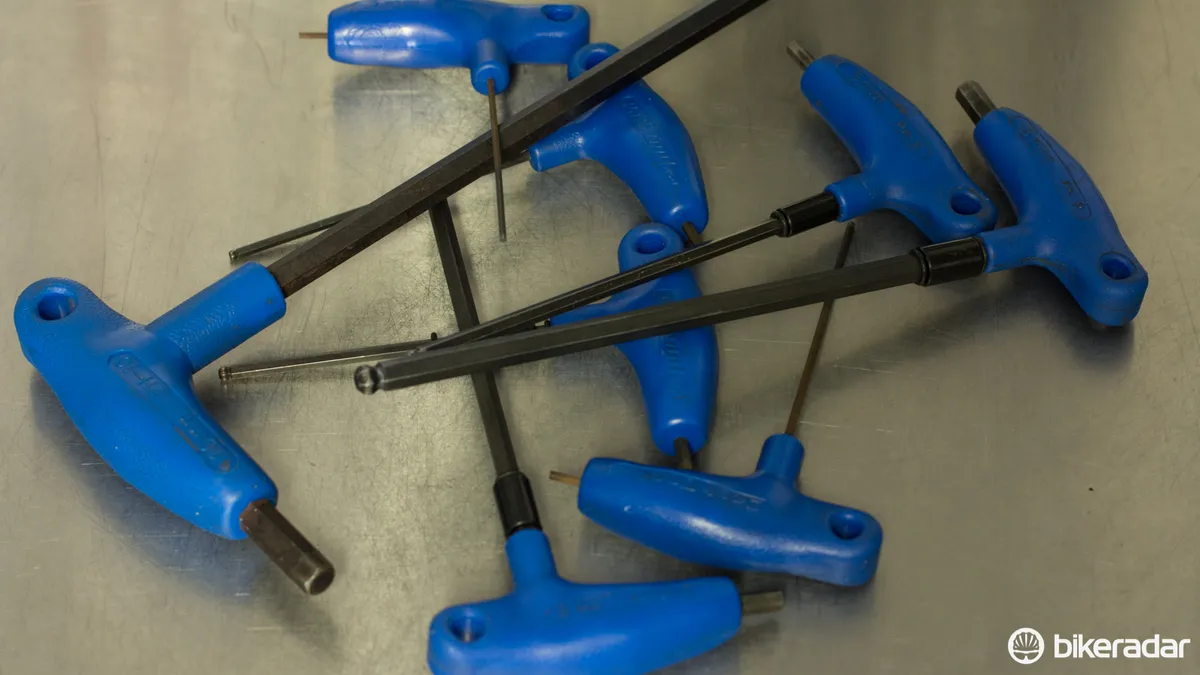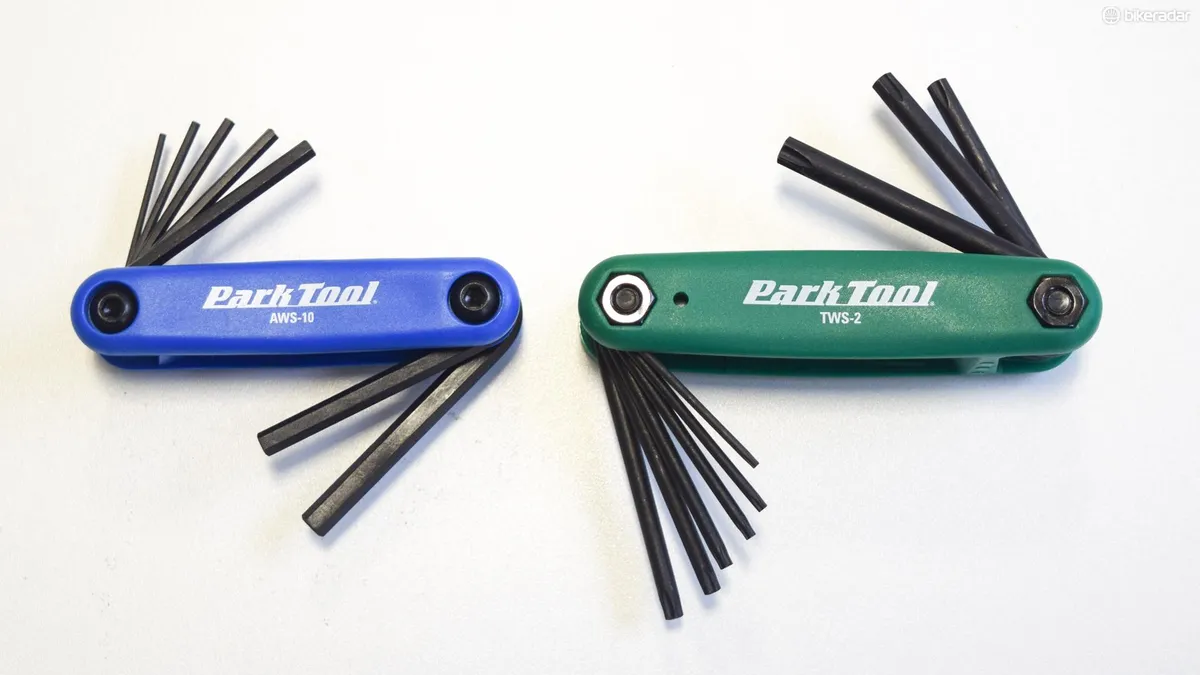Hex keys are often taken for granted because they are used so frequently and for so many jobs on a modern bicycle. In fact, it’s sometimes difficult to find a bolt on a bicycle that doesn’t have a hex or a Torx head.
From removing wheels to adjusting lock-on grips, it’s almost always a hex key that you need to reach for. There are different kinds, with various qualities, and some important ways to employ them to help you have the best time while working on your bike.
It’s time to learn the difference between a P- and T-handle, and why a multi-tool might be more use in the workshop than you first thought.
Don’t drop the ball

Ball-ended hex keys are a versatile and useful invention, but they have an important flaw.
The rounded end of a ball-ended hex key can be used at multiple angles, apart from 90 degrees, making them useful for solving problems caused by a lack of space. For bottle cage bolts and saddle rail clamps especially, these specialised Allen keys are a boon.
Unfortunately, they have a flaw in the lack of surface area that's in contact with the bolt.
The reason they can be used at an angle is their ball-ended shape, but this reduces the contact patch between the bolt to a minimum. This means they can be used only for low-torque applications.
If you try to torque up something such as a stem or a seat clamp with a ball-ended hex wrench, you’re very likely to damage the tool by rounding off the hex on the ball end.
You should always finish off components such as stems and seat clamps with a torque wrench anyway, so hopefully this won’t be problematic for your workflow, but it is important to remember it’s not possible to tighten bolts fully with the ball end of a hex key.
Also, if you’re looking to start off the thread on a bolt, and it’s difficult to use your fingers alone, a ball-ended hex key is of limited use: the ball shape means the bolt will droop down, change angle or fall off the hex key altogether.
P-handle

P-handles can either be ball-ended or straight. Ball-ended ones are useful on the tail of the P shape for the jobs mentioned above, and the P-handle can be turned 90 degrees to utilise the straight hex key when more torque is needed.
Jobs such as undoing bolts, or torquing them up fully, are done with the short side of the P-handle.
P-handles with two straight hex keys at 90 degrees are useful for spinning in and out bolts such as stem preload bolts with the long, tail-end.
They’re a more palm-friendly, ergonomic shape than a bare-metal hex key, and so are more comfortable to use and are less frequently dropped.
T-bars

T-bars have a handle forming the horizontal part of the ‘T’ and a hex key forming the vertical part of the T-shape.
In some ways, T-bars are a good compromise between an L-shaped hex key and a P-handle. Unlike a P-handle, they’re balanced side-to-side, so they’re more satisfying and faster to spin in or out bolts with. Also, due to the wider handle than a P-handle, it’s possible to generate more torque.
However, for larger-sized bolts, which need more force to torque up fully, a T-bar is of limited use: if you can’t perform final torque with a T-bar, you’ll have to put it down and pick up a hex key or P-handle to finish the job. In my opinion, T-handles larger than 6mm are a bit of a white elephant.
Multi-tools

Multi-tools with hex keys are often considered trail tools and not for workshop use, but having a multi-tool in the workshop can be a real time-saver.
As a former World Cup and bike shop mechanic, the time taken to swap between different-sized T-bars can increase the time taken to complete a job.
In a shop environment, bike builds need to be done as efficiently as possible, and in a race pit a good multi-tool can even be the difference between whether or not a racer makes it to the start line on time.
Finding one that will withstand such heavy use without rounding can be a challenge, though. Many shop mechanics prefer a Park AWS-10. It’s cost-effective, compact, ergonomic and impressively robust. It contains hex keys from 2mm to 6mm, and includes a 2.5mm, which is missing from many tools and is useful for parts such as lock-on grip collars and set-screws on derailleurs.
You can get enough torque through the handle of a multi-tool for most jobs, and even as the primary tool for a full-time bike shop or race mechanic, it can last for years with almost no wear.
Some multi-tools have an 8mm hex key, but if you’re going to use a hex key that large, you will usually need more leverage than a multi-tool can offer, so a hex key or P-handle is a better solution.
An exception is the Park AWS-11. This larger-style multi-tool is rather bulky for a trail tool, but ideal for your toolbox: it includes 8mm and 10mm keys. It’s a large, heavy (246g) tool, but the longer handle means you can generate some good torque.
Why do we call them Allen keys?

Hex keys were patented in 1909 by William Allen, hence often being referred to as ‘Allen keys’.
A square-headed or hex-headed bolt was found to catch on workers' clothing, so the Allen Safety Set Screw was designed to fix this problem. It had the added bonus that the recessed hex inside the head of the bolt was more compact, and it’s been widely adopted for use on bicycle components.
Torx keys

Torx keys are an evolution of the hex key, with Torx keys developed in 1969 and patented in 1971.
The idea behind a Torx key is that the tool will round off (become damaged) before the bolt, whereas a hex key will tend to round off the bolt, usually leaving the tool undamaged.
The advantage of a sacrificial tool (while more expensive) is you can revisit the bolt with a fresh tool, rather than wasting time trying various ways to remove a rounded bolt, which no tool will now fit.
You can’t have a ball-ended Torx key, which is one disadvantage when it comes to working on bolts with a Torx head.


